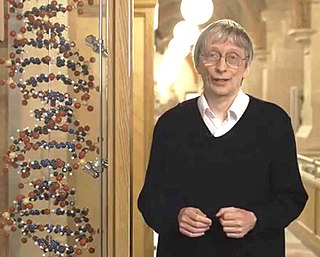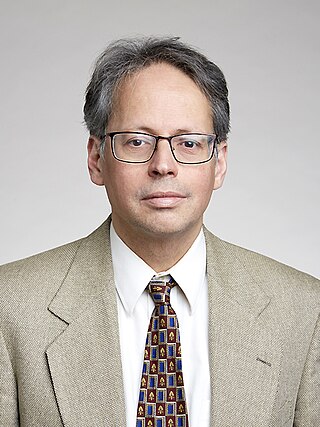Related Research Articles

David Elieser Deutsch is a British physicist at the University of Oxford. He is a visiting professor in the Department of Atomic and Laser Physics at the Centre for Quantum Computation (CQC) in the Clarendon Laboratory of the University of Oxford. He pioneered the field of quantum computation by formulating a description for a quantum Turing machine, as well as specifying an algorithm designed to run on a quantum computer. He has also proposed the use of entangled states and Bell's theorem for quantum key distribution and is a proponent of the many-worlds interpretation of quantum mechanics.
M-theory is a theory in physics that unifies all consistent versions of superstring theory. Edward Witten first conjectured the existence of such a theory at a string theory conference at the University of Southern California in 1995. Witten's announcement initiated a flurry of research activity known as the second superstring revolution. Prior to Witten's announcement, string theorists had identified five versions of superstring theory. Although these theories initially appeared to be very different, work by many physicists showed that the theories were related in intricate and nontrivial ways. Physicists found that apparently distinct theories could be unified by mathematical transformations called S-duality and T-duality. Witten's conjecture was based in part on the existence of these dualities and in part on the relationship of the string theories to a field theory called eleven-dimensional supergravity.
In physics, string theory is a theoretical framework in which the point-like particles of particle physics are replaced by one-dimensional objects called strings. String theory describes how these strings propagate through space and interact with each other. On distance scales larger than the string scale, a string looks just like an ordinary particle, with its mass, charge, and other properties determined by the vibrational state of the string. In string theory, one of the many vibrational states of the string corresponds to the graviton, a quantum mechanical particle that carries the gravitational force. Thus, string theory is a theory of quantum gravity.
In theoretical physics, T-duality is an equivalence of two physical theories, which may be either quantum field theories or string theories. In the simplest example of this relationship, one of the theories describes strings propagating in a spacetime shaped like a circle of some radius , while the other theory describes strings propagating on a spacetime shaped like a circle of radius proportional to . The idea of T-duality was first noted by Bala Sathiapalan in an obscure paper in 1987. The two T-dual theories are equivalent in the sense that all observable quantities in one description are identified with quantities in the dual description. For example, momentum in one description takes discrete values and is equal to the number of times the string winds around the circle in the dual description.
In algebraic geometry and theoretical physics, mirror symmetry is a relationship between geometric objects called Calabi–Yau manifolds. The term refers to a situation where two Calabi–Yau manifolds look very different geometrically but are nevertheless equivalent when employed as extra dimensions of string theory.
In mathematics and string theory, a conifold is a generalization of a manifold. Unlike manifolds, conifolds can contain conical singularities, i.e. points whose neighbourhoods look like cones over a certain base. In physics, in particular in flux compactifications of string theory, the base is usually a five-dimensional real manifold, since the typically considered conifolds are complex 3-dimensional spaces.

Andrew Eben Strominger is an American theoretical physicist who is the director of Harvard's Center for the Fundamental Laws of Nature. He has made significant contributions to quantum gravity and string theory. These include his work on Calabi–Yau compactification and topology change in string theory, and on the stringy origin of black hole entropy. He is a senior fellow at the Society of Fellows, and is the Gwill E. York Professor of Physics.

Dennis William Siahou Sciama, was an English physicist who, through his own work and that of his students, played a major role in developing British physics after the Second World War. He was the PhD supervisor to many famous physicists and astrophysicists, including John D. Barrow, David Deutsch, George F. R. Ellis, Stephen Hawking, Adrian Melott and Martin Rees, among others; he is considered one of the fathers of modern cosmology.
Richard Jozsa is an Australian mathematician who holds the Leigh Trapnell Chair in Quantum Physics at the University of Cambridge. He is a fellow of King's College, Cambridge, where his research investigates quantum information science. A pioneer of his field, he is the co-author of the Deutsch–Jozsa algorithm and one of the co-inventors of quantum teleportation.
Ian Philip Grant, DPhil; FRS; CMath; FIMA, FRAS, FInstP is a British mathematical physicist. He is Emeritus Professor of Mathematical Physics at the University of Oxford and was elected a fellow of the Royal Society in 1992. He is a pioneer in the field of computational physics and is internationally recognised as the principal author of GRASP, the General Relativistic Atomic Structure Program.
Douglas Alan Ross is a British physicist. As of 2017 he is Professor Emeritus of physics at the University of Southampton.
Christopher Michael Hull is a professor of theoretical physics at Imperial College London. Hull is known for his work on string theory, M-theory, and generalized complex structures. Edward Witten drew partially from Hull's work for his development of M-theory.
James Julian Bennett Jack is a New Zealand physiologist.

Richard Paul Winsley Thomas is a British mathematician working in several areas of geometry. He is a professor at Imperial College London. He studies moduli problems in algebraic geometry, and ‘mirror symmetry’—a phenomenon in pure mathematics predicted by string theory in theoretical physics.
Gary T. Horowitz is an American theoretical physicist who works on string theory and quantum gravity.

Mark William Gross is an American mathematician, specializing in differential geometry, algebraic geometry, and mirror symmetry.
Xenia de la Ossa Osegueda is a theoretical physicist whose research focuses on mathematical structures that arise in string theory. She is a professor at Oxford's Mathematical Institute.

Guy Roderick Wilkinson is a particle physicist, working on the Large Hadron Collider project at CERN, professor of physics at the University of Oxford and a Fellow of Christ Church, where he holds the college's Alfred Moritz Studentship.

Timothy Peter Softley is Pro-vice-chancellor (PVC) for research and knowledge transfer at the University of Birmingham.

Yang-Hui He is a mathematical physicist, who is a Fellow at the London Institute, which is based at the Royal Institution of Great Britain, as well as lecturer and former Fellow at Merton College, Oxford. He holds honorary positions as visiting professor of mathematics at City, University of London, Chang-Jiang Chair professor at Nankai University, and President of STEMM Global scientific society.
References
- 1 2 3 4 5 "CANDELAS, Prof. Philip" . Who's Who . Vol. 2017 (online Oxford University Press ed.). Oxford: A & C Black.(Subscription or UK public library membership required.)
- ↑ Philip Candelas at the Mathematics Genealogy Project
- ↑ Deutsch, David Elieser (1978). Boundary effects in quantum field theory. bodleian.ox.ac.uk (DPhil thesis). University of Oxford. EThOS uk.bl.ethos.453518.
- ↑ Deutsch, David; Candelas, Philip (1979). "Boundary effects in quantum field theory". Physical Review D. 20 (12): 3063–3080. Bibcode:1979PhRvD..20.3063D. doi:10.1103/physrevd.20.3063.
- 1 2 3 Anon (2010). "Professor Philip Candelas FRS". royalsociety.org. London: Royal Society. One or more of the preceding sentences incorporates text from the royalsociety.org website where:
All text published under the heading 'Biography' on Fellow profile pages is available under Creative Commons Attribution 4.0 International License." -- "Royal Society Terms, conditions and policies". Archived from the original on 11 November 2016. Retrieved 9 March 2016.
{{cite web}}: CS1 maint: bot: original URL status unknown (link) - 1 2 3 "Philip Candelas's CV" (PDF). www.maths.ox.ac.uk.
- 1 2 "Professor Philip Candelas". Mathematical Institute – University of Oxford. Retrieved 15 February 2013.
- ↑ "Scientific publications of Philip Candelas". inspirehep.net. INSPIRE-HEP.
- ↑ Philip Candelas publications indexed by the Scopus bibliographic database. (subscription required)
- ↑ Candelas, Philip (1977). Quantum Gravitation. bodleian.ox.ac.uk (DPhil thesis). University of Oxford. EThOS uk.bl.ethos.450645.
- ↑ P. Candelas; Gary T. Horowitz; Andrew Strominger; Edward Witten (1985), "Vacuum configurations for superstrings", Nuclear Physics B, 258: 46–74, Bibcode:1985NuPhB.258...46C, doi:10.1016/0550-3213(85)90602-9
![]() This article incorporates text available under the CC BY 4.0 license.
This article incorporates text available under the CC BY 4.0 license.